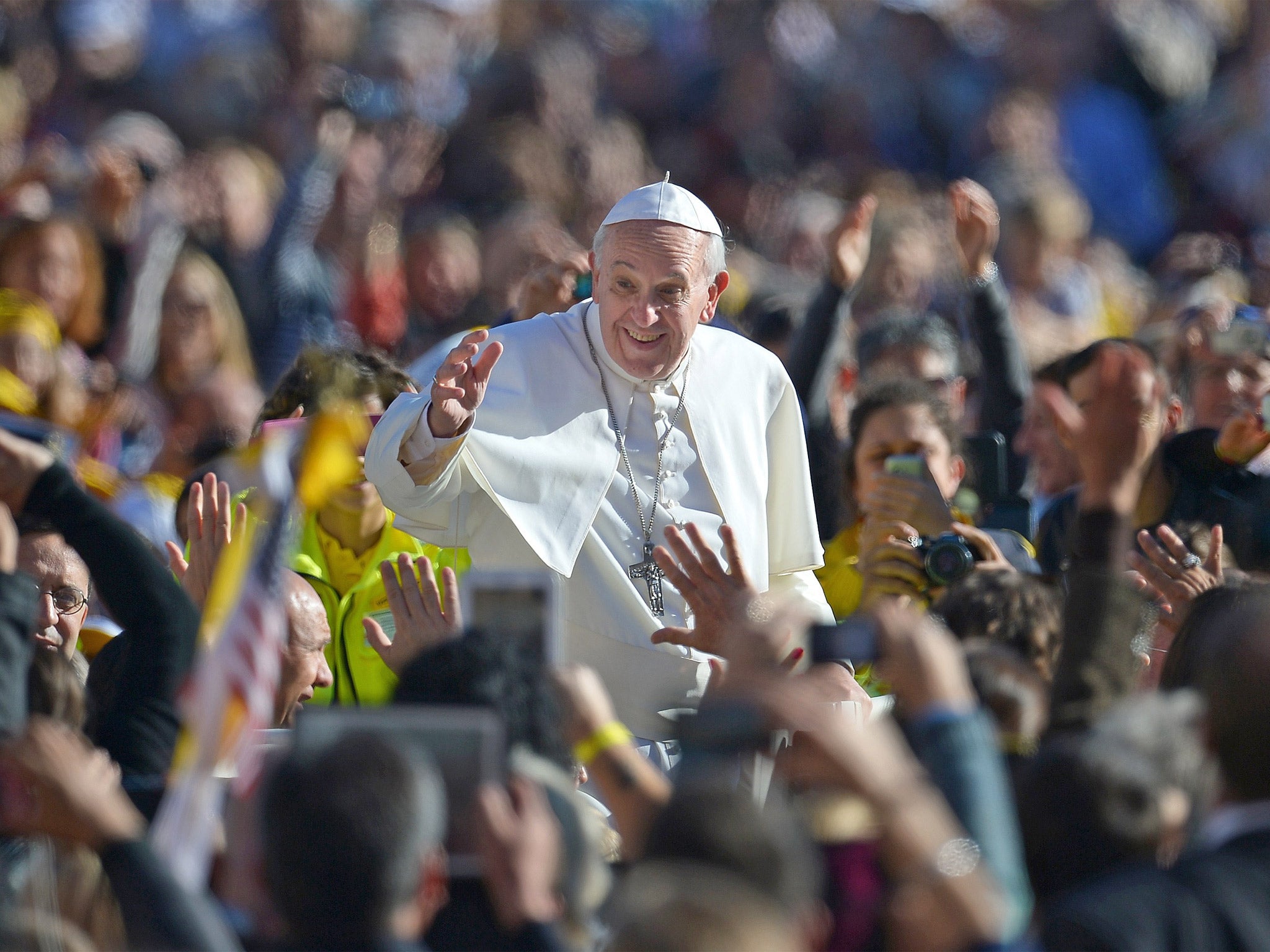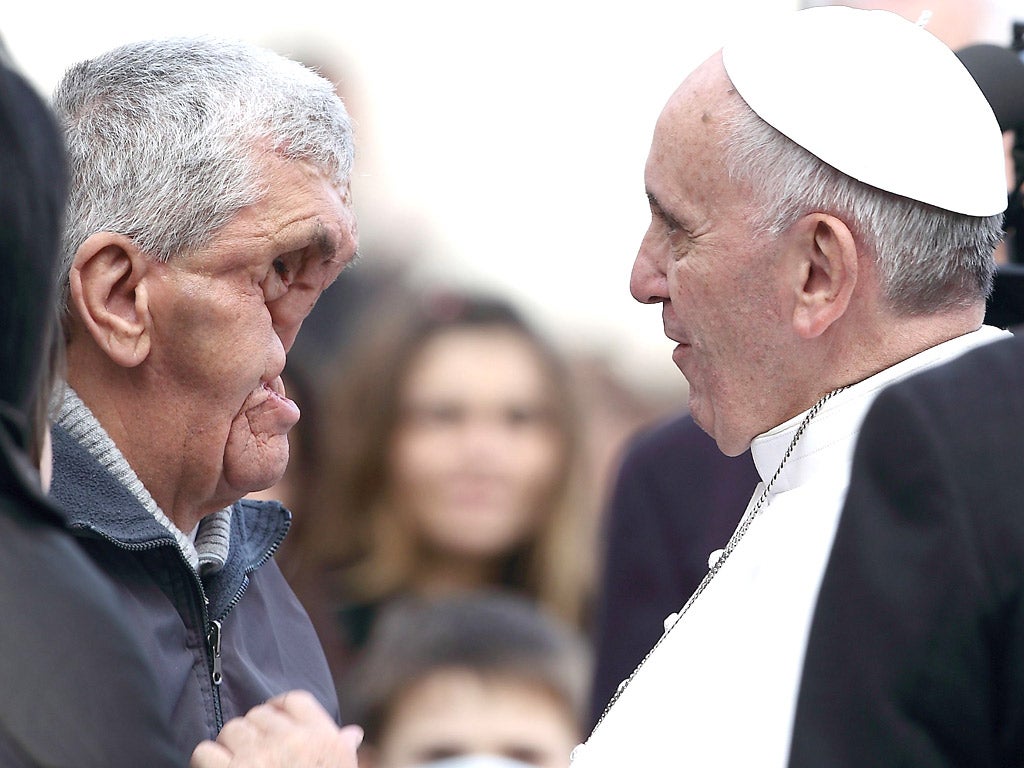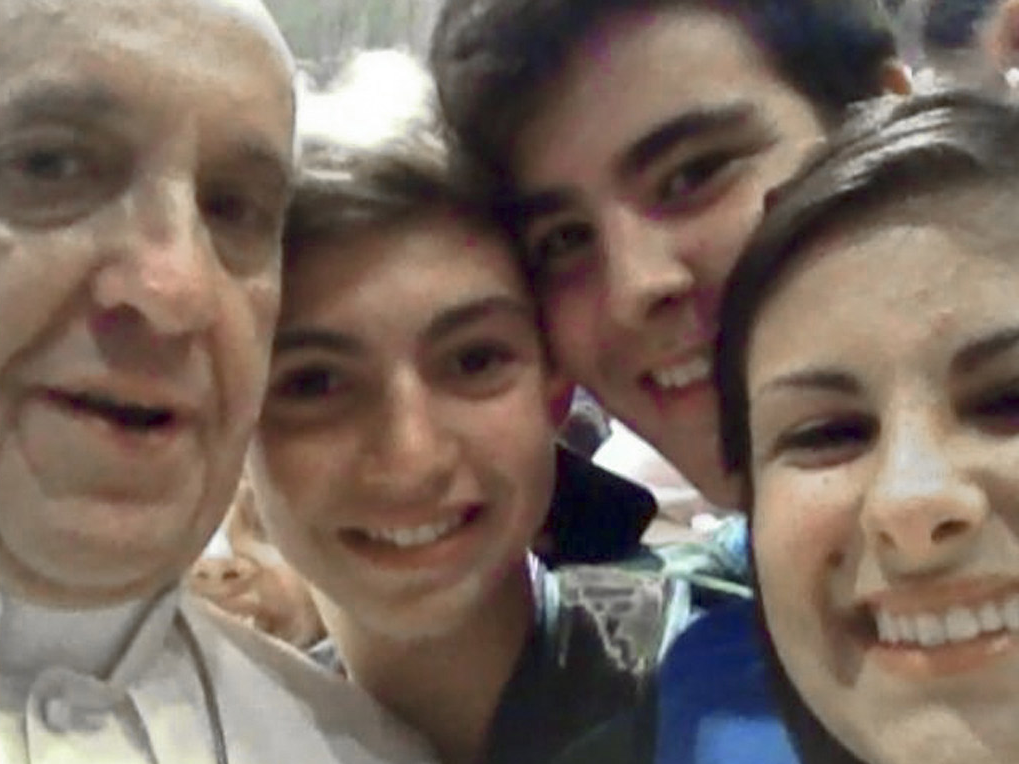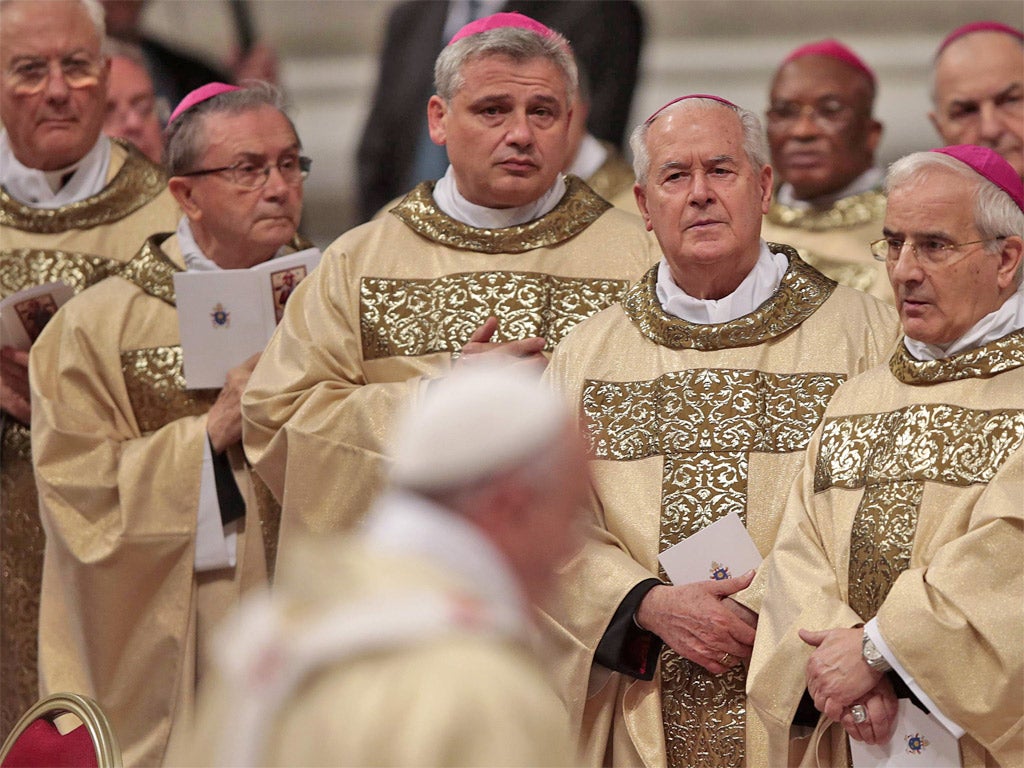Pope Idol... but Francis I knows the real battles are yet to come
He has won over the world’s media and the man on the street – but certainly not all Catholics

Your support helps us to tell the story
From reproductive rights to climate change to Big Tech, The Independent is on the ground when the story is developing. Whether it's investigating the financials of Elon Musk's pro-Trump PAC or producing our latest documentary, 'The A Word', which shines a light on the American women fighting for reproductive rights, we know how important it is to parse out the facts from the messaging.
At such a critical moment in US history, we need reporters on the ground. Your donation allows us to keep sending journalists to speak to both sides of the story.
The Independent is trusted by Americans across the entire political spectrum. And unlike many other quality news outlets, we choose not to lock Americans out of our reporting and analysis with paywalls. We believe quality journalism should be available to everyone, paid for by those who can afford it.
Your support makes all the difference.What a difference a year makes. In November 2012, as the nights drew in, the approaching winter mirrored the gloom felt by the Catholic Church, which was under siege from scandal, falling congregations and the feeling that its supposedly infallible leader wasn’t up to the job.
The fallout from the clerical paedophilia scandal continued to erode the Church’s moral credibility. Leaked documents told us of a “death threat” against Pope Benedict XVI and widespread nepotism and corruption. There were exiled whistle-blowers, gay smear campaigns and embarrassing revelations about the Vatican’s tax affairs.
Twelve months on, has a new, charismatic Pope – elected on 13 March –“decontaminated the Catholic brand”, asks The Daily Telegraph newspaper. Pope Francis I, the new man at the top, is very different from his immediate predecessors, John Paul II (the living saint) and his starchy successor Benedict. There are many descriptions of the Argentinian pontiff, but one of the most common is “down to earth”, a phrase that resonates with his mission to appear less like God’s representative and more of a champion of the poor.
Francis, 76, is perhaps the first pop-star Pope. YouGov polls shows 95 per cent positive approval ratings. His face adorns magazine covers. His huge celebrity is tempered, or even augmented, by glimpses of his domestic side: this week, we learned from a new biography that he cooks a mean paella. Compare this with his more traditional predecessors, who were more tight-lipped about whether they were punishing themselves with a plate of gruel or being served a beef stroganoff at any given meal time.
And in the age of papal “selfies” it can’t hurt that Francis looks right; like a pope, certainly, but friendly, avuncular. John Paul looked serious, distinguished; Benedict… odd, a little unsavoury, even – more Child Catcher in Chitty Chitty Bang Bang than Holy Father. If you’d caught Benedict doing a selfie with a group of youngsters, you might have called the police.
Despite winning pundits for his radical-but-graceful abdication, Francis’s predecessor, Benedict, fell victim to today’s inquisitive and insatiable 24-hour digital media. Francis, on the contrary, has milked it – or at least benefited from it. His impromptu phone calls to ordinary people have won hearts. And the picture of him embracing a man terribly deformed by tumours was genuinely touching. But while Francis’s status as a media darling and a Twitter phenomenon @Pontifex might provide a welcome reprieve after years of dismal headlines, how in tune is he with the Catholic rank and file?
Timothy Dolan, the Archbishop of New York, is in no doubt. “Viva il Papa,” he says on his website. “The world has fallen in love with Pope Francis… if I had a dollar for every New Yorker, Catholic and not, who has told me how much he or she loves our current Holy Father, I’d pay off the big repair bill of St Patrick’s Cathedral!”
It might be useful to remember, though, that this is the same US Cardinal who described hapless Benedict as “just what we needed after Pope John Paul II”. Appreciation for a figure as public as this one can wax and wane. And a quick look at the plethora of traditional Catholic blogs and websites confirms that many believers are far from happy with what Francis has been saying and doing at the Holy See.
By making friendly overtures to other faiths, washing the feet of women as well as men, appearing less condemnatory of gays, and stone-walling the hoary old issue of a return to Latin mass, Francis has caused much gnashing of teeth among conservatives, not just those on the loony fringes. The leading sites such as Rorate Caeli, for instance, document every little transgression produced by what they view as Francis’s perilously progressive tendencies.

Thus, in July, the Rorate Caeli site led with this bulletin: “Important: Pope Francis severely restricts the Franciscan Friars of the Immaculate from celebrating the Traditional Latin Mass, imposes the Novus Ordo on all their priests.” This choice, rather than placing importance on Francis’s hugely successful tour of Latin America that culminated with his triumphant appearance at the Roman Catholic World Youth Day festival on Rio’s Copacabana Beach, seems significant.
Back in March, in Francis’s native Argentina, the conservative Catholic commentator Marcelo Gonzalez reacted to Francis’s election with the phrase: “The horror.” Speaking at International Catholic Panorama, he was alarmed that his Church had elected a leader with little time for the institution’s traditional pomp and ceremony.
Closer to home, leading Vatican watcher Vito Mancuso said in La Repubblica last week that there was a “conservative campaign that sees Bergoglio [the surname Francis was born with] as a symbol to take out… Precisely the things that the world finds charming in Francis are, for these Catholics, a source of scandal that causes him to be seen as the most cheesy of populists”.
There are signs that Francis is aware of the serious conservative opposition and his need to tread carefully. He has made conciliatory overtures to Archbishop Agostino Marchetto, one of his fiercest conservative critics. An interview in La Repubblica with the Pope, in which he stated, among other things, that non-believers would be forgiven by God if they followed their consciences, has been quietly removed from the Vatican website.
Francis’s clearly stated intention to give the Church back to the people and to debate rather than dictate on previous no-go areas such as homosexuality is making waves beyond Rome and the blogosphere that watch it closely. Other important dioceses are seeing a similar confrontation. In the US modernisers and traditionalists are squaring up to decide who replaces Archbishop Dolan as head of the Bishops Conference, for example.
But Robert Mickens, the veteran Vatican correspondent of The Tablet, warns us not to overstate Francis’s “liberal tendencies” (despite what Sarah Palin thinks). “He is very much a conservative Catholic Bishop. That’s not in doubt,” he said. And there’s not been a peep from the first Argentinian Pope on the horrors perpetrated by Catholic missionaries on his continent, harrumphed liberal commentator George Monbiot this week.
From the other end of the (Catholic) political spectrum, the Rev John Zuhlsdorf, a traditionalist blogger who is quick to hit out at the first sign that progressives are committing liturgical abuses, appears to agree with Mickens. “Before liberals and traditionalists both have a spittle-flecked nutty, each for their own reasons, try to figure out what he is trying to do,” Zuhlsdorf wrote in one piece on Francis. “What liberals forget in their present crowing is that even as Francis makes himself – and the Church – more popular by projecting [a] compassionate image, he will simultaneously make it harder for them to criticise him when he reaffirms the doctrinal points they want him to overturn.”

Certainly, while appearing less keen to condemn gays or divorcees, there’s not much evidence that Francis intends to overturn traditional teachings on these subjects.
Some leading figures in the Vatican say Francis is neither liberal nor conservative and attempt to portray such labels as red herrings. Cardinal Gianfranco Ravasi, the president of the Pontifical Council for Culture who was once tipped as a possible successor to Benedict, told The Independent: “When you hear both accusations: people attacking him for being too liberal and others saying he remains a conservative Bishop, he’s probably on the right path... If he is radical, it’s probably in the sense he wants to return to the grand evangelical themes.” He was referring to Francis’s aim to prioritise the poor and bring the Church back to ordinary people. In his crusade to take his flock back to basics and deliver it from the clutches of Mammon, Francis said in June that the Church “must go forward... with a heart of poverty, not a heart of investment or of a businessman”. It is fair to say he has led from the top in this regard, eschewing ermine-trimmed robes, limousines and palatial pontifical dwellings.
It fits, then, that the area where Francis has made real impact is in the shady world of Vatican finances. He appears serious about cleaning out the stables at the Vatican’s bank, the Institute for Religious Works (Ior) that for decades has appeared more like a willing recipient of overseas slush funds than institution engaged in high finance.
In October it emerged that as part of Francis’s efforts to crack down on corruption, the troubled institution is seeking to close 900 suspicious accounts. According to the Corriere della Sera newspaper, four of the suspect accounts are linked to the Vatican embassies of Indonesia, Iran, Iraq and Syria. Earlier this year, a judicial report said the Vatican Bank was a money-laundering hot spot. As a measure of Francis’s progress, Nicola Gratteri, the prominent anti-Mafia magistrate, warned last week that organised crime, which has been linked to Vatican finances for as long as anyone can remember, was sufficiently alarmed to consider drastic action. “Pope Bergoglio is dismantling centres of economic power in the Vatican. If the [Mob] bosses can stop him, they won’t hesitate,” he said.

And if Francis can evade irate Mafia bosses and placate or triumph over Vatican traditionalists fearful of seeing their status or privileges disappear, another difficult constituency lies in wait for him.
As the first non-European pontiff of the modern era, the Second and Third World expects a lot from Francis. He has instructed a commission of cardinals from around the world to look at thorny topics such gay rights, abortion and women priests. But by inviting more involvement from countries in the developing world, he can also expect to have to deal with their more conservative positions on these issues, which will put them at odds with many Catholics in Europe and North America.
Another dilemma facing Francis is how he’ll implement his plan to tackle the Vatican’s corrupt and sclerotic administration. In particular, Francis will be aware of a key moral conundrum. How much of his own power – as the Vatican’s absolute monarch – should he employ to make the changes he thinks are needed, when one of these aims is to make the institution’s government more collegiate?
A solution is hiring friendly faces. Appointing Archbishop Pietro Parolin as his new Secretary of State and right-hand man has been seen as a smart move. Parolin, who has spent the past four years as the Vatican’s ambassador in Venezuela, is seen as canny operator who should prove a boon in the Pope’s plans to reform the Vatican bureaucracy.
“And that is the beginning of the problems for Francis in the next year or so,” says Mr Mickens, of The Tablet. “He will try to reform the curia (the Vatican’s administrative body). But there will be huge opposition. He’s got to be very, very, careful. There a people who feel they have a lot to lose.”
And, as such, the Pope will need every bit of his determination and much-vaunted charm.
Join our commenting forum
Join thought-provoking conversations, follow other Independent readers and see their replies
Comments